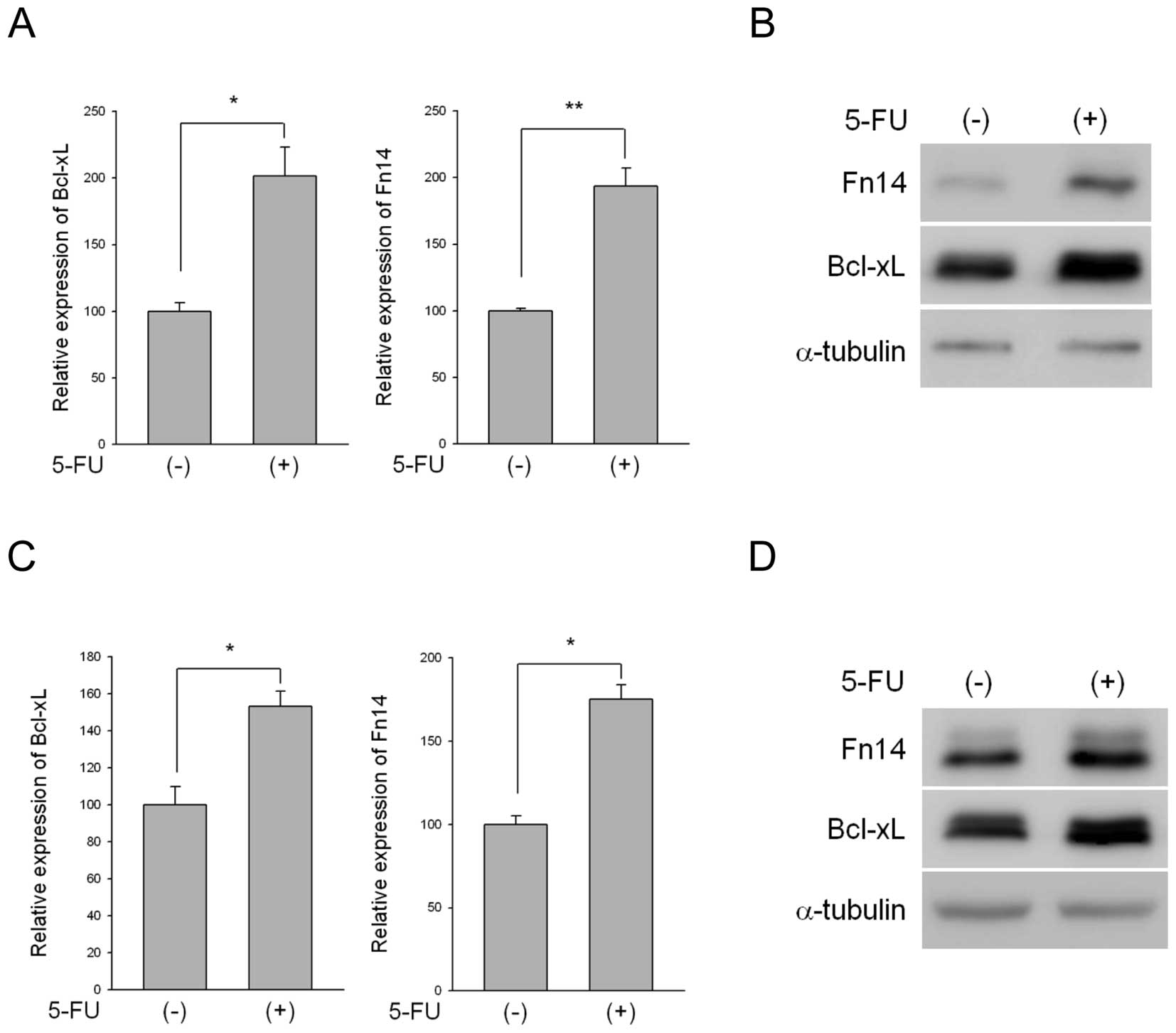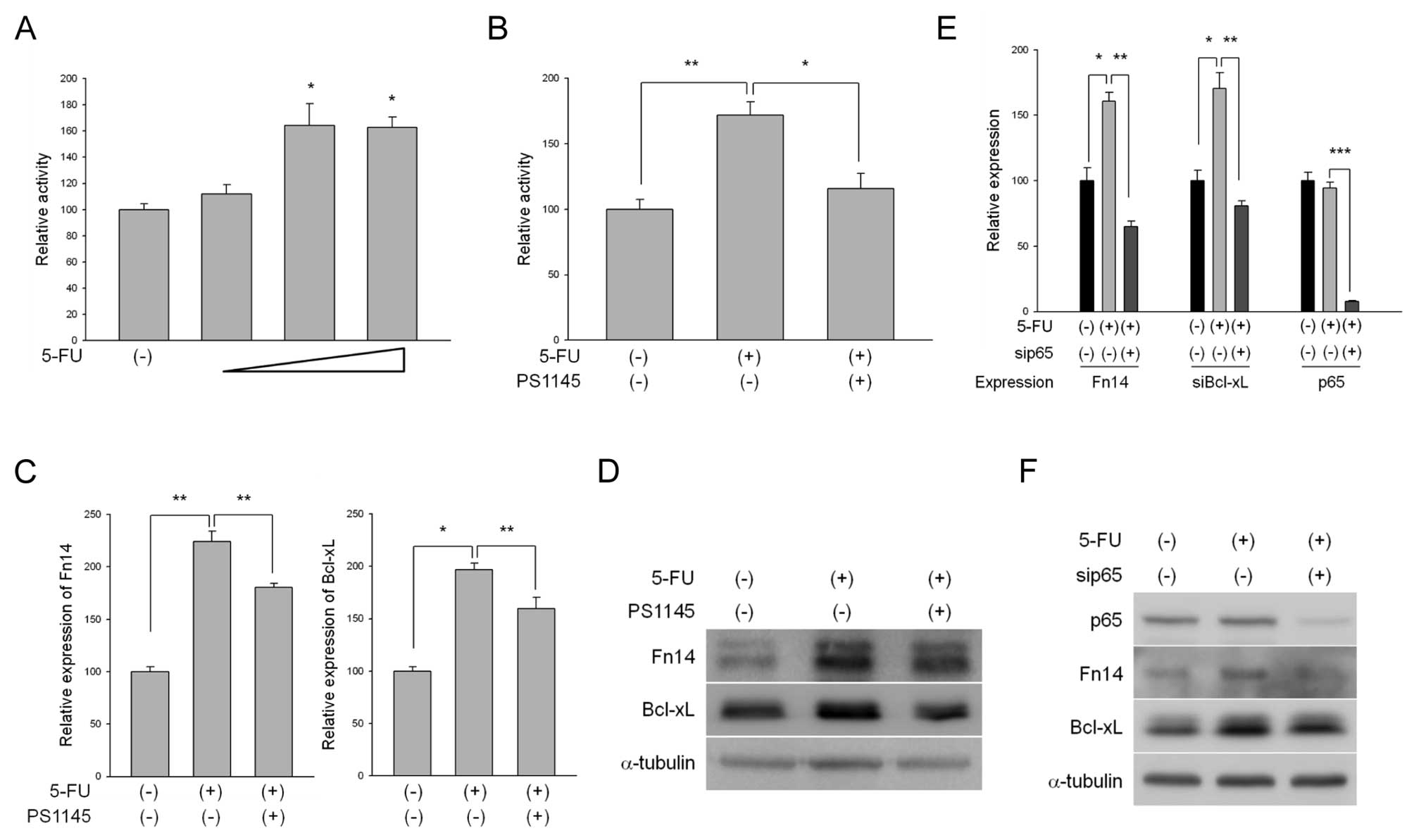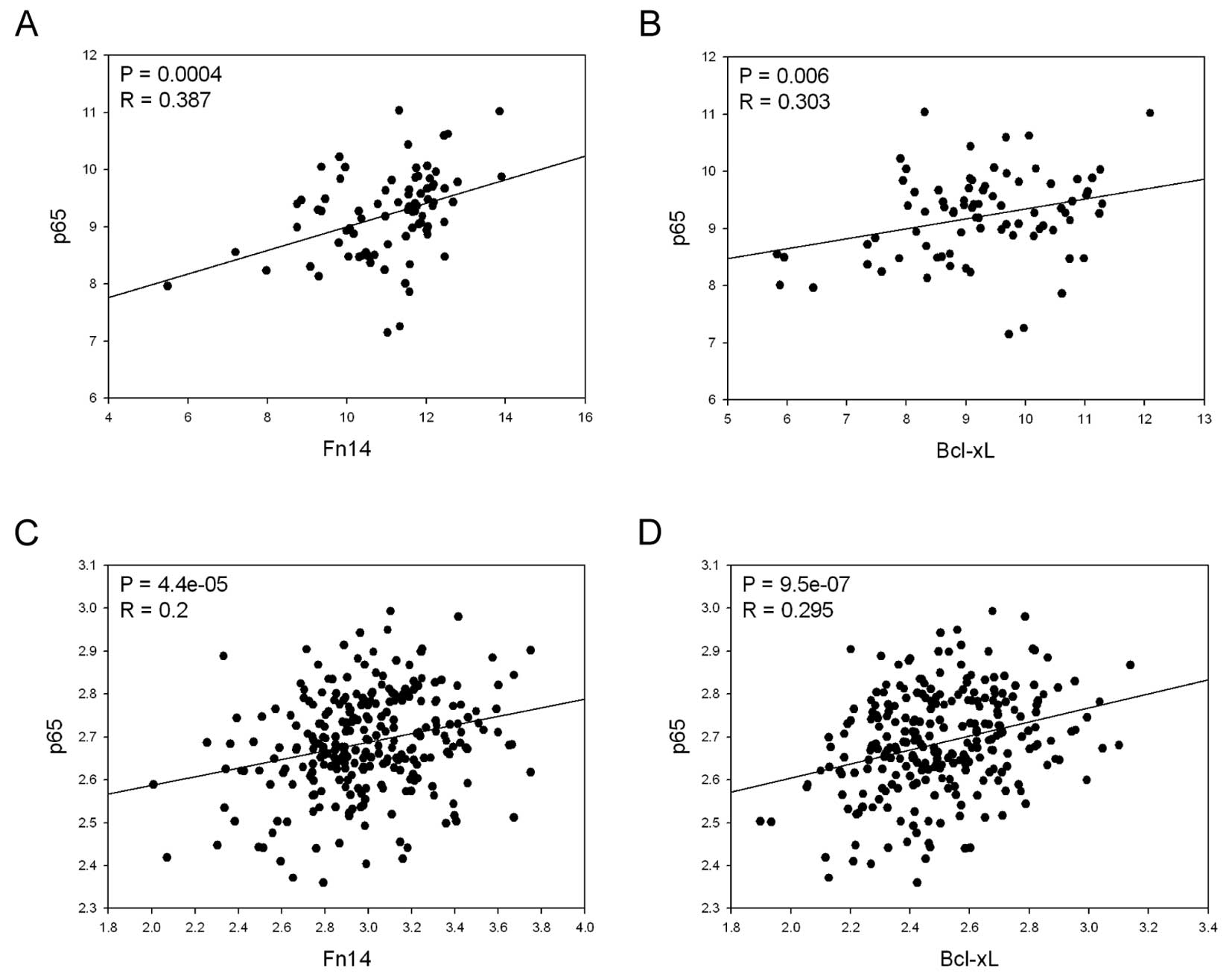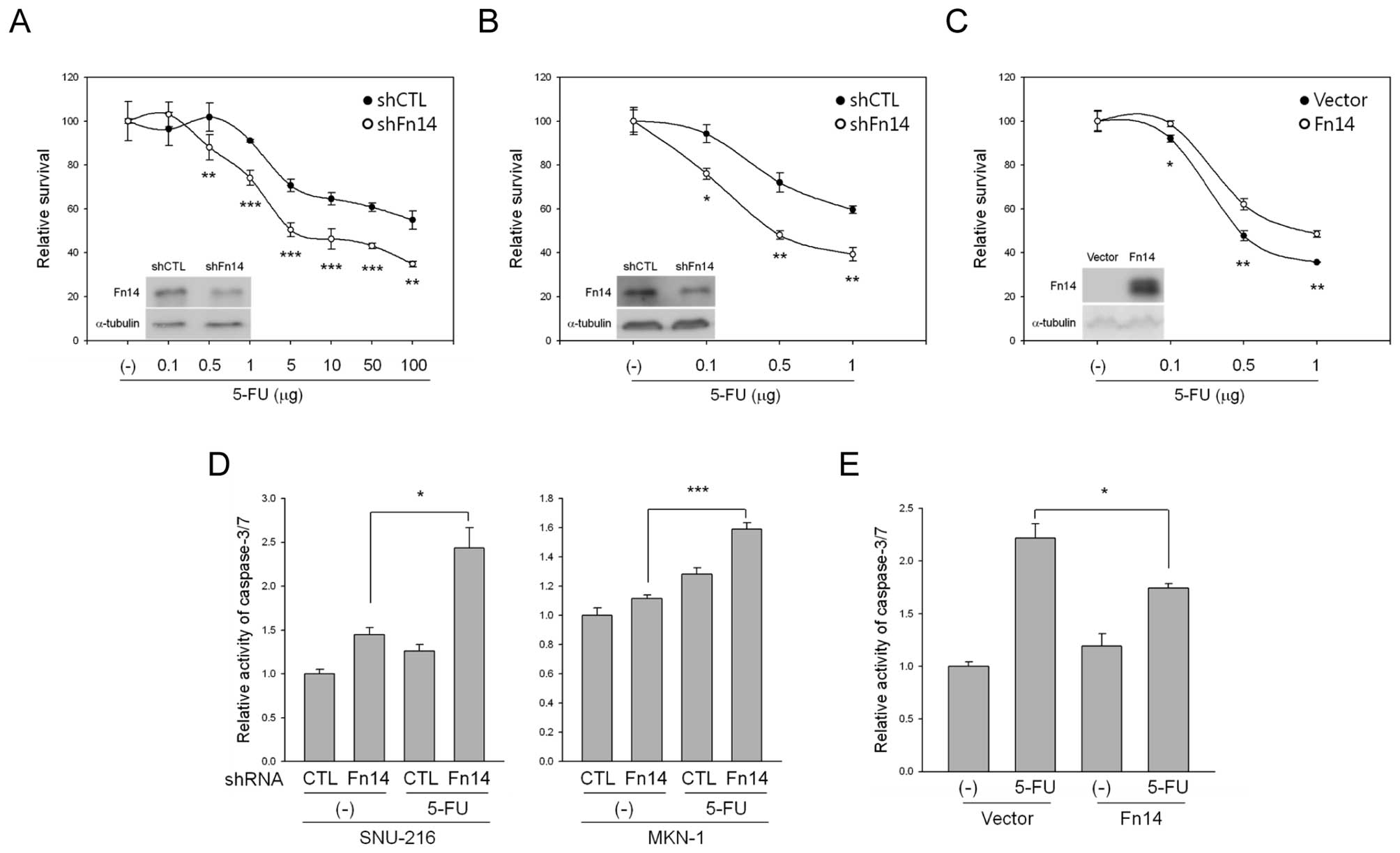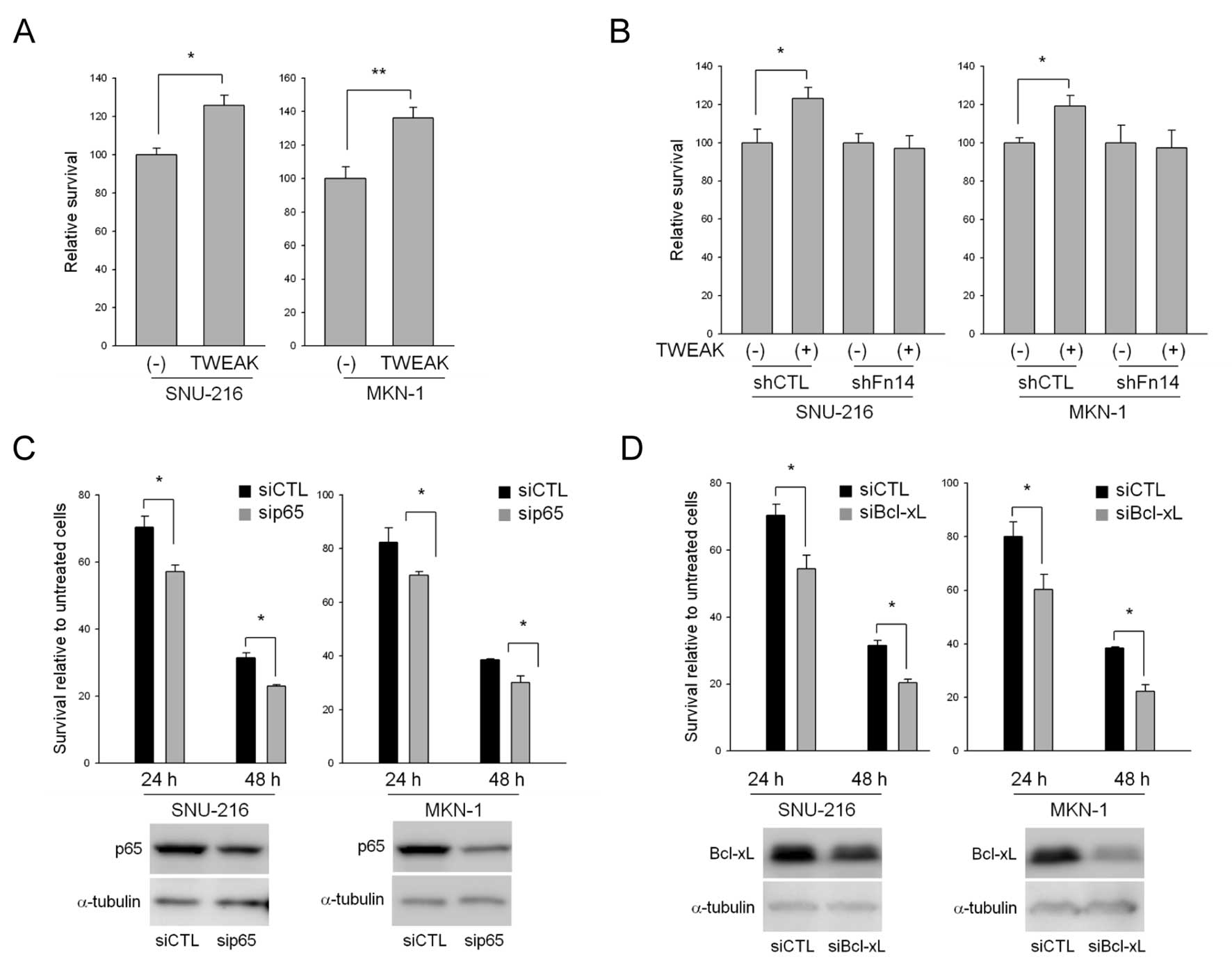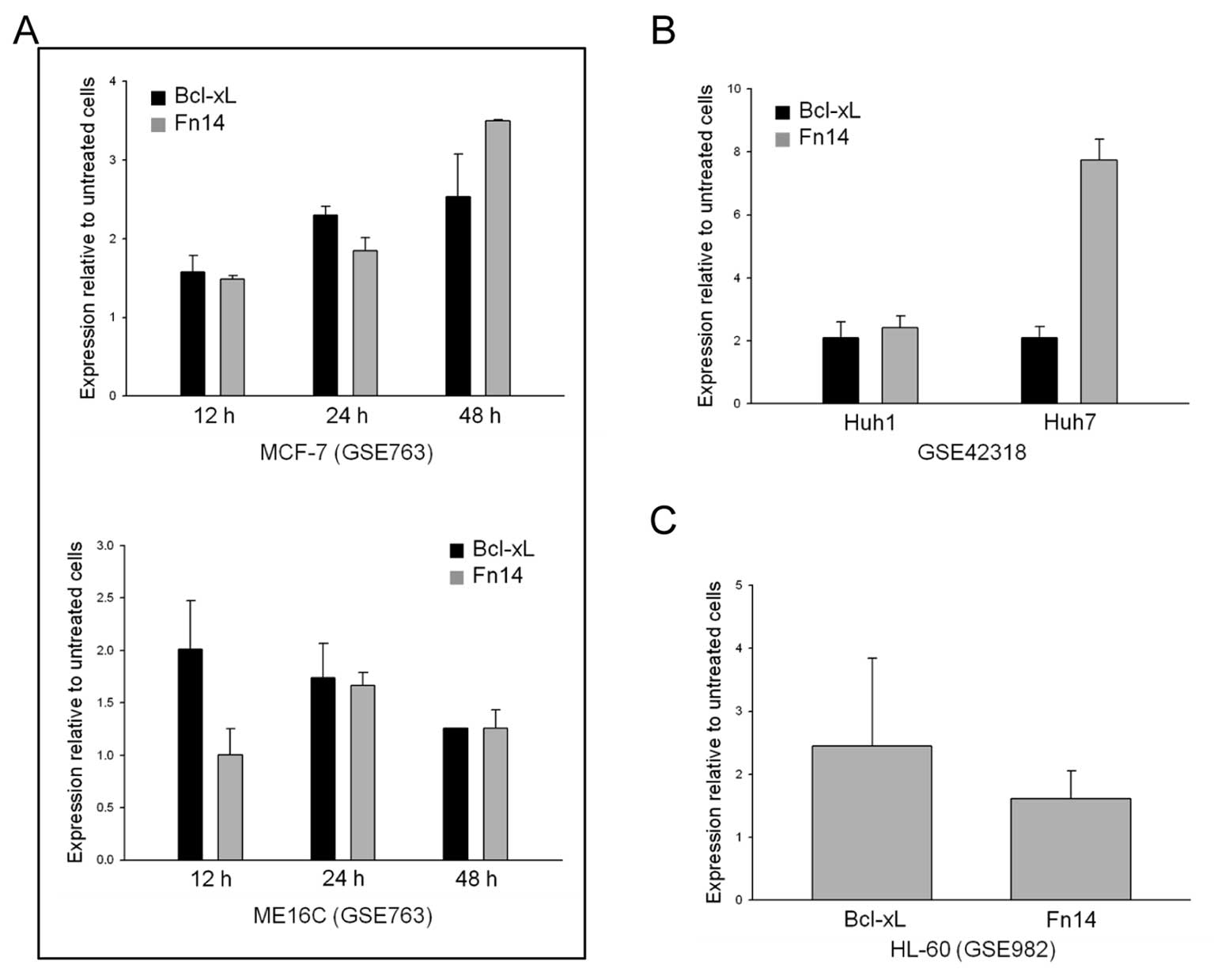TWEAK/Fn14 signaling mediates gastric cancer cell resistance to 5-fluorouracil via NF-κB activation
- Authors:
- Published online on: December 9, 2013 https://doi.org/10.3892/ijo.2013.2211
- Pages: 583-590
Abstract
Introduction
Fibroblast growth factor-inducible-14 (Fn14), originally identified as one of the growth factor-inducible genes present in murine fibroblasts, is the smallest member of the tumor necrosis factor (TNF) superfamily of receptors that lacks the cytoplasmic death domain (1–3). The Fn14 gene is expressed in many tissues, including the heart, placenta, kidneys, lungs, and pancreas, and is located on human chromosome 6 (2). In the GENT database, Fn14 is upregulated in many tumor tissues compared to normal tissues (4) and has also been reported to be elevated in various cancers, including GC (2,5,6). Addition of TNF-like weak inducer of apoptosis (TWEAK), a ligand for Fn14, activates Fn14 and increases cell survival, growth, and migration in some cancers (5,6). Inhibition of Fn14 expression decreases migration and invasion, whereas ectopic expression of Fn14 increases the invasive activity of prostate cancer cells (7). The levels of Fn14 expression also affect the growth of GC cells (6). A recent study reported that immunotoxins targeting the Fn14 receptor induce melanoma cell necrosis, which leads to growth inhibition (8), suggesting that Fn14 may be an appropriate therapeutic target for cancer.
NF-κB is activated in response to various inflammatory agents, carcinogens, tumor promoters, and growth factors and regulates the expression of various genes that are involved in immunity, inflammation, cell survival, or oncogenesis (9,10). NF-κB is an inhibitor of apoptotic cell death and activates several target genes that are involved in preventing the induction of apoptosis (11). NF-κB-mediated anti-apoptotic factors contain cIAPs, c-FLIP, and members of the Bcl-2 family (11). NF-κB is constitutively active in cancer cells and is highly resistant to antitumor drugs or ionizing radiation, while inhibition of NF-κB activity greatly promotes sensitivity to such treatments (12). TWEAK/Fn14 signaling is one of the important upstream stimulators of NF-κB activation resulting in induction of the expression of NF-κB-regulated anti-apoptotic genes (13,14). These anti-apoptotic genes are associated with the inhibition of apoptosis and the resistance to anticancer drugs, resulting in poor prognosis and shortened survival (15), suggesting that the TWEAK/Fn14/NF-κB cascade may be involved in chemoresistance.
Identification of the major molecules that regulate cancer resistance and the development of new strategies to treat the disease are required to find an effective cure for cancer. Gastric cancer is a common malignancy that is associated with a high mortality rate. It is the fourth most commonly diagnosed cancer in the world and the third most common cause of cancer-related deaths (16). Although many antitumor drugs have been used to treat patients with cancer, drug resistance has become a serious problem. Overcoming the problem of drug resistance could improve the efficacy of antitumor drugs. 5-FU is a chemotherapeutic agent that is widely used for the treatment of GC. 5-FU exerts its toxic effects on cancer cells by inducing apoptosis (17,18). However, the mechanism by which 5-FU activates the apoptotic process is not fully understood in GC. Clarification of the underlying mechanism may help to decrease the frequency of resistance to 5-FU-induced cell death in cancer. In this study, we investigated how the Fn14 molecule contributes to 5-FU chemoresistance in GC cells.
Materials and methods
Cell lines
Gastric cancer cell lines were cultured in complete RPMI-1640 medium. 293T cells were maintained in complete DMEM media. All cell lines were obtained from the Korean Cell Line Bank (http://cellbank.snu.ac.kr/index.htm), and all complete media contained 10% fetal bovine serum (Hyclone, Logan, UT, USA), 100 U/ml of penicillin/streptomycin (Invitrogen, Carlsbad, CA, USA), 2 mM L-glutamine, and 0.5 mM HEPES.
Lentiviral packaging and transduction of Fn14 small hairpin RNA (shRNA)
A non-targeting shRNA control vector (catalog no. SHC002) and shRNA lentiviral vectors targeting human Fn14 mRNA (catalog no. TRCN0000072451) were purchased from Sigma-Aldrich. For lentivirus production, the shRNA vector was cotransfected with the lentiviral packaging mix (Sigma-Aldrich, Taufkirchen, Germany) into 293T cells using FuGENE HD (Roche Diagnostics, Indianapolis, IN, USA) according to the manufacturer’s protocol. SNU-216 and MKN-1 cells were infected and selected using 1 μg/ml of puromycin. Fn14 protein reduction was assessed using western blot analysis.
Fn14 stable cell lines
Fn14 expression plasmids (6) were transfected into AGS cells using Lipofectamine Plus reagent (Invitrogen) according to the manufacturer’s protocol. Transfected cells were cultured for 2 days prior to selection in the presence of 1 mg/ml of G418 in complete medium. Fn14 protein levels were assessed using western blot analysis.
Transfection and luciferase reporter assays
SNU-216 cells were seeded into a 24-well plate 1 day prior to transfection. The cells were transiently transfected with the NF-κB luciferase reporter gene (Clontech, Palo Alto, CA, USA) using Lipofectamine Plus reagent (Invitrogen) according to the manufacturer’s protocol and were treated with either various amounts of 5-FU, 20 μg of 5-FU alone, or 20 μg of 5-FU in combination with 20 μM PS1145 for 24 h. Forty-eight hours after transfection, the cells were harvested, and luciferase activity was determined using the luciferase assay system (Promega, Madison, WI, USA) with a luminometer. Luciferase activities were normalized to β-galactosidase activity using the β-galactosidase enzyme assay system (Promega) according to the manufacturer’s instructions.
siRNA transfection
A non-targeting siRNA control (catalog no. SN1003) and siRNAs targeting human Bcl-xL (catalog no. 1011922) or p65 mRNA (catalog no. 1128166) were purchased from Bioneer (Daejeon, Korea). For siRNA transfection, SNU-216 and MKN-1 cells were transfected with siRNAs (100 nM) using Lipofectamine Plus (Invitrogen), and the knockdown of Bcl-xL and p65 was quantified 48 h post-transfection using qRT-PCR and western blotting. To assess the effects of Bcl-xL and p65 siRNA on cell growth, SNU-216 and MKN-1 cells were seeded in 96-well plates and transfected with siRNAs (100 nM) using Lipofectamine plus (Invitrogen). Cell growth was measured 24 and 48 h after 5-FU treatment using the CCK-8 reagent (Dojindo, Kumamoto, Japan).
Real-time RT-PCR
Total RNA was isolated from GC tissues using an RNeasy kit (Qiagen, Valencia, CA, USA) according to the manufacturer’s instructions prior to treatment with DNase I (Promega). DNase-treated RNA was reverse transcribed using Superscript II reverse transcriptase (Invitrogen). qRT-PCR was performed using an Exicycler Quantitative Thermal Block (Bioneer). The resulting cDNA was amplified using 2X SYBR Premix EX Taq (Takara, Shiga, Japan). β-actin was used as a loading control. The fold change in the expression of each gene was calculated using the ΔΔCt method (19). The primer sequences used were as follows: human p65, 5′-GCGAGAGGAGCACAGATACC-3′ (forward) and 5′-CTGATAGCCTGCTCCAGGTC-3′ (reverse); human Fn14, 5′-TTT CTG GCT TTT TGG TCT GG-3′ (forward) and 5′-CTT GTG GTT GGA GGA GCT TG-3′ (reverse); Bcl-xL, 5′-CTG AAT CGG AGA TGG AGA CC-3′ (forward) and 5′-TGG GAT GTC AGG TCA CTG AA-3′ (reverse); and human β-actin, 5′-CAA GAG ATG GCC ACG GCT GCT-3′ (forward) and 5′-TCC TTC TGC ATC CTG TCG GCA-3′ (reverse).
Western blot analyses
The cells were pelleted and lysed in NP-40 lysis buffer (20 mM Tris-HCl, pH 8.0, 140 mM NaCl, 10% glycerol, 1% NP-40, 2 mM EDTA, and protease inhibitor). Protein levels were quantified using the Bio-Rad protein assay method. The cell lysates were separated using SDS-PAGE. After electrophoresis, the proteins were transferred to nitrocellulose membranes, blotted with the relevant antibodies, and detected using ECL reagent (Amersham Bioscience, Buckinghamshire, UK). The primary antibodies used included Fn14 (Cell Signaling, Beverly, MA, USA), Bcl-xL (Cell Signaling), p65 (Santa Cruz Biotechnology, Santa Cruz, CA, USA), phosphor-IκB (Cell Signaling), IκB (Santa Cruz Biotechnology), and α-tubulin (Sigma).
Caspase-3/7 assay
SNU-216 and MKN-1 cells were seeded in 96-well plates and treated with 5-FU. After 48 h of treatment, the cells were washed once with 1X PBS, trypsinized, washed again with 1X PBS, and then resuspended in PBS. The cells were mixed with caspase-Glo-3/7 reagent (Promega) and incubated for 1 h at room temperature with agitation. The luciferase activity was measured using a luminometer and then normalized according to protein concentration.
Cell growth assay
Cells from different groups were plated into 96-well plates at 1×104 cells/well and maintained at 37°C in a humidified incubator. The cells were treated with various amounts of 5-FU for 48 h. To assess the effect of TWEAK on cell survival, the cells were treated with 50 μg (SNU-216) or 20 μg (MKN-1) of 5-FU alone or in combination with TWEAK (100 ng/ml) for 24 h. Cell growth was measured using the cell counting kit (CCK)-8 (Dojindo).
Statistical analyses
Statistical analyses of differences between groups were performed using Student’s t-test. A P<0.05 was considered to be significant.
Results
5-FU treatment upregulates the levels of Fn14 mRNA and protein in gastric cancer cells
NF-κB is known to be activated by 5-FU, resulting in increased resistance to this drug (20), and the Fn14 promoter is known to contain NF-κB binding sites, allowing for positive feedback between Fn14 and NF-κB to occur (21). The results of our previous studies also revealed that Fn14 overexpression increased NF-κB transcriptional activity in gastric cancer cells (6). Therefore, we investigated whether Fn14 was involved in chemoresistance in general and in 5-FU resistance in particular. We first examined Fn14 expression after 5-FU treatment of gastric cancer cells. Treatment with 5-FU upregulated Fn14 expression at both the mRNA and protein levels in SNU-216 and MKN-1 cells (Fig. 1). We also examined Bcl-xL expression because Bcl-xL is regulated by Fn14 and NF-κB (6) and the expression of Bcl-xL is induced by 5-FU. Bcl-xL is also known to be upregulated in 5-FU-resistant colon cancer cells (22). As predicted, Bcl-xL was upregulated following 5-FU treatment in both cell lines (Fig. 1).
5-FU upregulates Fn14 gene expression via NF-κB activation
We investigated the underlying mechanism by which Fn14 gene expression was upregulated following 5-FU treatment. We first performed NF-κB luciferase assays to examine 5-FU-mediated alterations in NF-κB transcriptional activity. 5-FU treatment increased the activity of the NF-κB reporter gene in a dose-dependent manner (Fig. 2A). We further confirmed that inhibition of NF-κB activity was increased by 5-FU using the IκB kinase (IKK) inhibitor PS1145 (Fig. 2B). We then inspected the expression levels of Fn14 after treatment of the cells with 5-FU alone or in combination with PS1145. As a result of 5-FU treatment, the increased levels of Fn14 expression were significantly reduced by PS1145 treatment at both the mRNA and protein levels (Fig. 2C and D). Bcl-xl also displayed similar results to those observed for Fn14 (Fig. 2C and D). In an effort to confirm the effects of NF-κB on Fn14 expression following 5-FU treatment, we used p65 siRNA to directly inhibit p65 expression. Similar to the results obtained following PS1145 treatment, knockdown of p65 reduced the increased expression levels of Fn14 as well as Bcl-xL following 5-FU treatment (Fig. 2E and F), indicating that the 5-FU-mediated upregulation of Fn14 expression occurred as a result of NF-κB activation. We further examined the relationship between the expression levels of p65 and Fn14, as well as those of p65 and Bcl-xL, using the GENT database in gastric cancer cell lines and tissues (4). We observed significant positive correlations between the expression levels of those genes in gastric cancer cell lines and tissues (Fig. 3), further supporting the notion that strong connections between these genes exist in gastric cancer.
Fn14 restrains 5-FU-induced apoptosis
To investigate whether Fn14 expression had an effect on 5-FU-induced cell death, we transduced Fn14 shRNA into SNU-216 and MKN-1 cells using a lentiviral system. Transduction with Fn14 shRNA resulted in reduced levels of Fn14 protein compared to transduction with control shRNA (Fig. 4A and B). We then examined whether reduced levels of Fn14 expression promoted sensitivity to 5-FU. As shown in Fig. 3A and B, the reduction of Fn14 expression by shRNA accelerated 5-FU-mediated inhibition of cell growth in both SNU-216 and MKN-1 cells. In contrast, overexpression of Fn14 by stable Fn14 DNA transfection in ASG cells weakened 5-FU-mediated inhibition of cell growth (Fig. 4C). We next exposed the cells to 5-FU and analyzed caspase-3/7 activity using caspase-3/7 reagent. As shown in Fig. 4D, downregulation of Fn14 significantly increased caspase-3/7 activity compared to control shRNA. In contrast, overexpression of Fn14 decreased caspase-3/7 activity compared to empty vector-transfected cells (Fig. 4E), indicating that Fn14 is an important determinant of apoptotic sensitivity following 5-FU treatment in these cells.
TWEAK stimulation also protects gastric cancer cells against 5-FU-induced apoptosis
TWEAK transactivates the Bcl-xL promoter via NF-κB activation and increases resistance to cytotoxic therapy-induced apoptosis in glioma cells (23). Therefore, we treated cells with 5-FU alone or in combination with TWEAK and then examined the effects of TWEAK on 5-FU-induced cell death. TWEAK treatment increased the rate of cell survival compared to 5-FU treatment alone in both SNU-216 and MKN-1 cells (Fig. 5A). Although Fn14 is known to be a TWEAK receptor, TWEAK can mediate the differentiation of RAW264.7 cells, which do not express Fn14, into osteoclasts, indicating that other TWEAK receptors exist in cells (24). To investigate whether these effects of TWEAK on 5-FU resistance were mediated through the Fn14 receptor, we treated cells expressing normal (shCTL) or reduced levels of Fn14 (shFn14) with 5-FU alone or in combination with TWEAK and then examined the rates of cell survival. TWEAK had no effect on 5-FU-induced apoptosis in shFn14-transduced cells compared to control cells (Fig. 5B).
The presumption of NF-κB involvement in TWEAK/Fn14-mediated resistance to 5-FU was ascertained using p65 siRNA. We first transiently transfected p65 siRNA into SNU-216 and MKN-1 cells and confirmed the reduced levels of p65 expression at the protein level via western blotting in both cell lines (Fig. 5C). The survival rate of p65 siRNA-transfected cells was compared with control siRNA-transfected cells after 5-FU treatment. The results indicated that knock-down of p65 promoted sensitivity to 5-FU (Fig. 5C). We then examined the involvement of Bcl-xL in 5-FU resistance because Bcl-xL is a target gene of NF-κB as well as Fn14, as mentioned previously. Knock-down of Bcl-xL using siRNA also accelerated 5-FU sensitivity compared to control siRNA (Fig. 5D).
Bcl-xL and Fn14 are also upregulated by 5-FU in various cancer cell lines
We wondered whether the upregulation of Fn14 expression by 5-FU was limited to gastric cancer cells. To investigate whether the effects of 5-FU on Fn14 expression occurred in other cancer cell lines, we downloaded gene expression microarray data from the NCBI Gene Expression Omnibus (GEO) and examined the expression of Fn14 in various cancer cell lines. We discovered that various cell lines displayed Bcl-xL and Fn14 upregulation after 5-FU treatment (Fig. 6). Interestingly, Fn14 expression was upregulated by 5-FU treatment in both solid (Fig. 6A and B) and liquid (Fig. 6C) tumor cells, indicating that the relationship between Fn14 and Bcl-xL expression and 5-FU is universal in cancer.
Discussion
NF-κB plays an important role in cell proliferation, apoptosis, and resistance to antitumor agents (25,26). In the field of chemotherapy, persistent activation of NF-κB interrupts the effects of antitumor drugs, resulting in increased resistance to these agents (27). Therefore, the regulation of NF-κB activity may be a useful therapeutic strategy for treating cancer because drug resistance is the major reason for cancer therapy failure. We previously reported that Fn14 is involved in the growth of gastric cancer cells through NF-κB activation, leading to upregulation of the anti-apoptotic protein Bcl-xL, which is an anti-apoptotic member of the Bcl-2 family that is involved in cancer chemoresistance (28), and that high levels of Fn14 expression are associated with poor clinical outcomes among gastric cancer patients (6). These results prompted us to examine the relationship between Fn14 and NF-κB in chemo-resistance in gastric cancer. Although NF-κB is widely known to be involved in chemoresistance in cancer, additional studies are necessary to clarify the underlying mechanism by which NF-κB contributes to chemoresistance in cancer in general and in gastric cancer in particular.
5-FU-induced apoptosis is mediated predominantly by the mitochondrial apoptotic pathway, which occurs as a result of the activation of cytochrome c-mediated caspase-3 (17,18). Evidence indicates that management of the mitochondrial apoptotic pathway may, at least in part, contribute to solving the problem of drug resistance. Bcl-2 and Bcl-xL block the release of cytochrome c followed by caspase-3 activation through stabilization of mitochondrial membrane integrity and subsequent regulation of the mitochondrial apoptotic pathway (18,22). Indeed, Bcl-xL is overexpressed in 5-FU-resistant cells and knock-down of Bcl-xL expression promotes sensitivity to 5-FU in colon cancer (29). In addition, Bcl-xL shows anti-apoptotic effects on other antitumor drug (30). Consistent with this evidence, our present study showed that Bcl-xL was upregulated by 5-FU and that knock-down of Bcl-xL hastened the 5-FU-induced growth inhibition of gastric cancer cells, indicating that Bcl-xL is one of the main determinants in chemoresistance.
A previous study demonstrated that TWEAK prevents glioma cells from TRAIL- or camptothecin-induced cell death through activation of the NF-κB pathway and that TWEAK increased the expression of anti-apoptotic proteins (23). A recent report also showed that Fn14 expression correlates with p-EGFR levels and is upregulated in EGFR-mutant cells that contain an EGFR TKI-resistant mutation (31), indicating that the TWEAK/Fn14 pathway is involved in resistance to anti-tumor drugs. In our present study, we showed that knock-down or overexpression of Fn14 led to the promotion of sensitivity or resistance to 5-FU, respectively. The effects of Fn14 on antitumor drugs are likely related to activation of the NF-κB pathway. NF-κB is widely known to be regulated by TWEAK/ Fn14 signaling, indicating that TWEAK/Fn14 signaling may contribute to constitutive NF-κB activity in gastric cancer cells and, hence, may lead to resistance to multiple antitumor drugs.
The HER2 proto-oncogene, which is a transmembrane tyrosine kinase receptor and a member of the ErbB protein family, is considered to be a putative Fn14 inducer. Expression of HER2 is significantly associated with that of Fn14 in breast cancer (32). Although it is not clear whether HER2 directly regulates Fn14 expression, it is of interest to note that HER2 can activate NF-κB (33) and, hence, may lead to upregulation of Fn14 gene expression. HER-2-overexpressing breast cancer cells are less responsive to antitumor drugs than cells that normally express HER-2, and ectopic expression of HER-2 promotes resistance to chemotherapies (34,35), suggesting that activation of the NF-κB/Fn14 cascade by HER-2 may be involved in chemoresistance. Fn14 activation is also elicited by proinflammatory cytokines, including IFN-γ and IL-1β, and treatment with the HMG-CoA reductase inhibitor atorvastatin, which is known to decrease NF-κB activation, diminishes cytokine-induced Fn14 expression in vascular smooth muscle cells (36,37). In addition, increased secretion of IL-1β by nitric oxide (NO) leads to the induction of chemoresistance in pancreatic carcinoma cells (38). Our study using public data revealed that 5-FU treatment upregulated Fn14 expression in various cancer cell lines independent of tumor type (solid or liquid tumor). Taken together, these results strongly suggest that Fn14 may be involved in chemoresistance in many cancers as an up- or down-stream regulator.
In conclusion, we revealed that Fn14 and Bcl-xL were upregulated by 5-FU-mediated NF-κB activation and promoted resistance to 5-FU in gastric cancer cells. In addition, we demonstrated that Fn14 is a new facilitative determinant in NF-κB-mediated resistance to 5-FU in gastric cancer. Positive feedback between TWEAK, Fn14, and NF-κB may give rise to more synergistic restraints on chemotherapy. Although it is necessary for us to elucidate whether Fn14 only limits the function of 5-FU in gastric cancer, the results presented here support the notion that Fn14 targeting may elevate the efficacy of current GC therapies. These results may also apply to other cancers because we discovered that Fn14 is upregulated by 5-FU in various cancer cell lines.
Abbreviations:
|
5-FU |
5-fluorouracil; |
|
GC |
gastric cancer; |
|
CCK-8 |
cell counting kit-8 |
Acknowledgements
This study was supported by grants from the Genomics Research Program (2012M3A9D1054670), the Future-Based Technology Development Program (NRF2011-0015710), and the KRIBB Research Initiative Program that are funded by the Korean Ministry of Education, Science and Technology.
References
|
Meighan-Mantha RL, Hsu DK, Guo Y, et al: The mitogeninducible Fn14 gene encodes a type I transmembrane protein that modulates fibroblast adhesion and migration. J Biol Chem. 274:33166–33176. 1999. View Article : Google Scholar : PubMed/NCBI | |
|
Feng SL, Guo Y, Factor VM, et al: The Fn14 immediate-early response gene is induced during liver regeneration and highly expressed in both human and murine hepatocellular carcinomas. Am J Pathol. 156:1253–1261. 2000. View Article : Google Scholar : PubMed/NCBI | |
|
Wiley SR, Cassiano L, Lofton T, et al: A novel TNF receptor family member binds TWEAK and is implicated in angiogenesis. Immunity. 15:837–846. 2001. View Article : Google Scholar : PubMed/NCBI | |
|
Shin G, Kang TW, Yang S, Baek SJ, Jeong YS and Kim SY: GENT: gene expression database of normal and tumor tissues. Cancer Inform. 10:149–157. 2011.PubMed/NCBI | |
|
Tran NL, McDonough WS, Donohue PJ, et al: The human Fn14 receptor gene is up-regulated in migrating glioma cells in vitro and overexpressed in advanced glial tumors. Am J Pathol. 162:1313–1321. 2003. View Article : Google Scholar : PubMed/NCBI | |
|
Kwon OH, Park SJ, Kang TW, et al: Elevated fibroblast growth factor-inducible 14 expression promotes gastric cancer growth via nuclear factor-kappaB and is associated with poor patient outcome. Cancer Lett. 314:73–81. 2012. View Article : Google Scholar : PubMed/NCBI | |
|
Huang M, Narita S, Tsuchiya N, et al: Overexpression of Fn14 promotes androgen-independent prostate cancer progression through MMP-9 and correlates with poor treatment outcome. Carcinogenesis. 32:1589–1596. 2011. View Article : Google Scholar : PubMed/NCBI | |
|
Zhou H, Ekmekcioglu S, Marks JW, et al: The TWEAK receptor Fn14 is a therapeutic target in melanoma: immunotoxins targeting Fn14 receptor for malignant melanoma treatment. J Invest Dermatol. 133:1052–1062. 2013. View Article : Google Scholar : PubMed/NCBI | |
|
Silverman N and Maniatis T: NF-kappaB signaling pathways in mammalian and insect innate immunity. Genes Dev. 15:2321–2342. 2001. View Article : Google Scholar : PubMed/NCBI | |
|
Karin M: Nuclear factor-kappaB in cancer development and progression. Nature. 441:431–436. 2006. View Article : Google Scholar : PubMed/NCBI | |
|
Karin M and Lin A: NF-kappaB at the crossroads of life and death. Nat Immunol. 3:221–227. 2002. View Article : Google Scholar : PubMed/NCBI | |
|
Wang CY, Cusack JC Jr, Liu R and Baldwin AS Jr: Control of inducible chemoresistance: enhanced anti-tumor therapy through increased apoptosis by inhibition of NF-kappaB. Nat Med. 5:412–417. 1999. View Article : Google Scholar : PubMed/NCBI | |
|
Saitoh T, Nakayama M, Nakano H, Yagita H, Yamamoto N and Yamaoka S: TWEAK induces NF-kappaB2 p100 processing and long lasting NF-kappaB activation. J Biol Chem. 278:36005–36012. 2003. View Article : Google Scholar : PubMed/NCBI | |
|
Sevilla L, Zaldumbide A, Pognonec P and Boulukos KE: Transcriptional regulation of the bcl-x gene encoding the anti-apoptotic Bcl-xL protein by Ets, Rel/NFkappaB, STAT and AP1 transcription factor families. Histol Histopathol. 16:595–601. 2001.PubMed/NCBI | |
|
Johnstone RW, Ruefli AA and Lowe SW: Apoptosis: a link between cancer genetics and chemotherapy. Cell. 108:153–164. 2002. View Article : Google Scholar : PubMed/NCBI | |
|
Jemal A, Bray F, Center MM, Ferlay J, Ward E and Forman D: Global cancer statistics. CA Cancer J Clin. 61:69–90. 2011. View Article : Google Scholar | |
|
Sun Y, Tang XM, Half E, Kuo MT and Sinicrope FA: Cyclooxygenase-2 overexpression reduces apoptotic susceptibility by inhibiting the cytochrome c-dependent apoptotic pathway in human colon cancer cells. Cancer Res. 62:6323–6328. 2002.PubMed/NCBI | |
|
Martinou JC, Desagher S and Antonsson B: Cytochrome c release from mitochondria: all or nothing. Nat Cell Biol. 2:E41–E43. 2000. View Article : Google Scholar : PubMed/NCBI | |
|
Livak KJ and Schmittgen TD: Analysis of relative gene expression data using real-time quantitative PCR and the 2(-Delta Delta C(T)) method. Methods. 25:402–408. 2001. View Article : Google Scholar : PubMed/NCBI | |
|
Fukuyama R, Ng KP, Cicek M, et al: Role of IKK and oscillatory NFkappaB kinetics in MMP-9 gene expression and chemoresistance to 5-fluorouracil in RKO colorectal cancer cells. Mol Carcinog. 46:402–413. 2007. View Article : Google Scholar : PubMed/NCBI | |
|
Tran NL, McDonough WS, Savitch BA, et al: Increased fibroblast growth factor-inducible 14 expression levels promote glioma cell invasion via Rac1 and nuclear factor-kappaB and correlate with poor patient outcome. Cancer Res. 66:9535–9542. 2006. View Article : Google Scholar : PubMed/NCBI | |
|
Konishi T, Sasaki S, Watanabe T, Kitayama J and Nagawa H: Overexpression of hRFI inhibits 5-fluorouracil-induced apoptosis in colorectal cancer cells via activation of NF-kappaB and upregulation of BCL-2 and BCL-XL. Oncogene. 25:3160–3169. 2006. View Article : Google Scholar : PubMed/NCBI | |
|
Tran NL, McDonough WS, Savitch BA, Sawyer TF, Winkles JA and Berens ME: The tumor necrosis factor-like weak inducer of apoptosis (TWEAK)-fibroblast growth factor-inducible 14 (Fn14) signaling system regulates glioma cell survival via NFkappaB pathway activation and BCL-XL/BCL-W expression. J Biol Chem. 280:3483–3492. 2005. View Article : Google Scholar | |
|
Polek TC, Talpaz M, Darnay BG and Spivak-Kroizman T: TWEAK mediates signal transduction and differentiation of RAW264.7 cells in the absence of Fn14/TweakR. Evidence for a second TWEAK receptor J Biol Chem. 278:32317–32323. 2003.PubMed/NCBI | |
|
Garg A and Aggarwal BB: Nuclear transcription factor-kappaB as a target for cancer drug development. Leukemia. 16:1053–1068. 2002. View Article : Google Scholar : PubMed/NCBI | |
|
Escarcega RO, Fuentes-Alexandro S, Garcia-Carrasco M, Gatica A and Zamora A: The transcription factor nuclear factor-kappa B and cancer. Clin Oncol (R Coll Radiol). 19:154–161. 2007. View Article : Google Scholar : PubMed/NCBI | |
|
Dolcet X, Llobet D, Pallares J and Matias-Guiu X: NF-κB in development and progression of human cancer. Virchows Arch. 446:475–482. 2005. | |
|
Reed JC: Bcl-2 family proteins: regulators of apoptosis and chemoresistance in hematologic malignancies. Semin Hematol. 34:9–19. 1997.PubMed/NCBI | |
|
Zhu H, Guo W, Zhang L, et al: Bcl-XL small interfering RNA suppresses the proliferation of 5-fluorouracil-resistant human colon cancer cells. Mol Cancer Ther. 4:451–456. 2005.PubMed/NCBI | |
|
Lei X, Huang Z, Zhong M, Zhu B, Tang S and Liao D: Bcl-XL small interfering RNA sensitizes cisplatin-resistant human lung adenocarcinoma cells. Acta Biochim Biophys Sin. 39:344–350. 2007. View Article : Google Scholar : PubMed/NCBI | |
|
Whitsett TG, Cheng E, Inge L, et al: Elevated expression of Fn14 in non-small cell lung cancer correlates with activated EGFR and promotes tumor cell migration and invasion. Am J Pathol. 181:111–120. 2012. View Article : Google Scholar : PubMed/NCBI | |
|
Willis AL, Tran NL, Chatigny JM, et al: The fibroblast growth factor-inducible 14 receptor is highly expressed in HER2-positive breast tumors and regulates breast cancer cell invasive capacity. Mol Cancer Res. 6:725–734. 2008. View Article : Google Scholar : PubMed/NCBI | |
|
Merkhofer EC, Cogswell P and Baldwin AS: Her2 activates NF-kappaB and induces invasion through the canonical pathway involving IKKalpha. Oncogene. 29:1238–1248. 2010. View Article : Google Scholar : PubMed/NCBI | |
|
Tsai CM, Yu D, Chang KT, et al: Enhanced chemoresistance by elevation of p185neu levels in HER-2/neu-transfected human lung cancer cells. J Natl Cancer Inst. 87:682–684. 1995. View Article : Google Scholar : PubMed/NCBI | |
|
Gusterson BA, Gelber RD, Goldhirsch A, et al: Prognostic importance of c-erbB-2 expression in breast cancer. International (Ludwig) Breast Cancer Study Group J Clin Oncol. 10:1049–1056. 1992.PubMed/NCBI | |
|
Munoz-Garcia B, Martin-Ventura JL, Martinez E, et al: Fn14 is upregulated in cytokine-stimulated vascular smooth muscle cells and is expressed in human carotid atherosclerotic plaques: modulation by atorvastatin. Stroke. 37:2044–2053. 2006. View Article : Google Scholar | |
|
Ortego M, Bustos C, Hernandez-Presa MA, et al: Atorvastatin reduces NF-kappaB activation and chemokine expression in vascular smooth muscle cells and mononuclear cells. Atherosclerosis. 147:253–261. 1999. View Article : Google Scholar : PubMed/NCBI | |
|
Muerkoster S, Wegehenkel K, Arlt A, et al: Tumor stroma interactions induce chemoresistance in pancreatic ductal carcinoma cells involving increased secretion and paracrine effects of nitric oxide and interleukin-1beta. Cancer Res. 64:1331–1337. 2004. View Article : Google Scholar |



